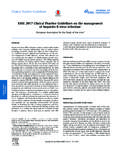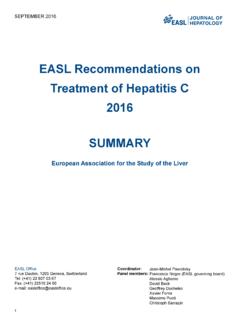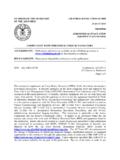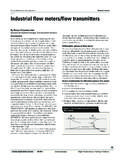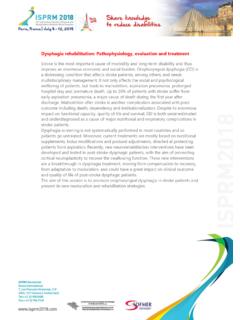Transcription of EASL–EORTC Clinical Practice Guidelines: Management of ...
1 EASL EORTC Clinical Practice Guidelines: Managementof hepatocellular carcinomaEuropean Association for the Study of the Liver ,European Organisation for Research and Treatment of CancerIntroductionEASL EORTC Clinical Practice Guidelines (CPG) on the manage-ment of hepatocellular carcinoma (HCC) define the use of surveil-lance, diagnosis, and therapeutic strategies recommended forpatients with this type of cancer. This is the first European jointeffort by the European Association for the Study of the Liver(EASL) and the European Organization for Research and Treat-ment of Cancer (EORTC) to provide common guidelines for themanagement of hepatocellular carcinoma .
2 These guidelinesupdate the recommendations reported by the EASL panel ofexperts in HCC published in 2001 [1]. Several Clinical and scien-tific advances have occurred during the past decade and, thus, amodern version of the document is urgently purpose of this document is to assist physicians, patients,health-care providers, and health-policy makers from Europe andworldwide in the decision-making process according to evidence-based data. Users of these guidelines should be aware that therecommendations are intended to guide Clinical Practice in cir-cumstances where all possible resources and therapies are avail-able. Thus, they should adapt the recommendations to their localregulations and/or team capacities, infrastructure, and cost benefit strategies.
3 Finally, this document sets out some recom-mendations that should be instrumental in advancing theresearch and knowledge of this disease and ultimately contributeto improve patient EASL EORTC CPG on the Management of hepatocellularcarcinoma provide recommendations based on the level of evi-dence and the strength of the data (the classification of evidenceis adapted from National Cancer Institute [2]) (Table 1A) and thestrength of recommendations following previously reported sys-tems (GRADE systems) (Table 1B). Clinical Practice SummaryThe Clinical Practice guidelines below will give advice for up todate Management of patients with HCC as well as providing anin-depth review of all the relevant data leading to the Practice SummarySurveillance Patients at high risk for developing HCC should be entered into surveillance programs.
4 Groups at high risk are depicted in Table 3 (evidence 1B/3A; recommendation 1A/B) Surveillance should be performed by experienced personnel in all at-risk populations using abdominal ultrasound every 6 months(evidence 2D; recommendation 1B)Exceptions: A shorter follow-up interval (every 3-4 months) is recommended in the following cases: (1). Where a nodule of less than 1 cm has been detected (see recall policy), (2). In the follow-up strategy after resection or loco-regional therapies (evidence 3D; recommendation 2B) Patients on the waiting list for liver transplantation should be screened for HCC in order to detect and manage tumor progression and to help define priority policies for transplantation (evidence 3D; recommendation 1B)Recall policy In cirrhotic patients, nodules less than 1 cm in diameter detected by ultrasound should be followed every 4 months the first year and with regular checking every 6 months thereafter(evidence 3D.)
5 Recommendation 2B) In cirrhotic patients, diagnosis of HCC for nodules of 1-2 cm in diameter should be based on non-invasive criteria or biopsy-proven pathological confirmation. In the latter case, it is recommended that biopsies are assessed by an expert hepatopathologist. A second biopsy is recommended in case of inconclusive findings, or growth or change in enhancement pattern identified during follow-up(evidence 2D; recommendation 1B) In cirrhotic patients, nodules more than 2 cm in diameter can be diagnosed for HCC based on typical features on one imaging technique. In case of uncertainty or atypical radiological findings, diagnosis should be confirmed by biopsy (evidence 2D; recommendation 1A)Journal of Hepatology2012vol.
6 56j908 943 Received 15 December 2011; accepted 15 December 2011 Contributors: Chairmen:Josep M. Llovet (EASL); Michel Ducreux (EORTC).ClinicalPractice Guidelines Members:Riccardo Lencioni; Adrian M. Di Bisceglie; Peter ; Jean Francois Dufour; Tim F. Greten; Eric Raymond; Tania Roskams; Thierry DeBaere; Michel Ducreux; and Vincenzo Governing Board Repre-sentatives:Mauro :Jordi Bruix; Massimo Colombo; Andrew Zhu. Correspondence: EASL Office, 7 rue des Battoirs, CH-1205 Geneva, : +41 22 807 0360; fax: +41 22 328 ( European Association for the Study ofthe Liver).Abbreviations:HCV, Hepatitis C virus; SNP, Single nucleotide polymorphism; PEG,Polyethylene glycol; HALT-C, Hepatitis C antiviral long-term treatment againstcirrhosis; EPIC, Evaluation of PegIntron in control of hepatitis C cirrhosis; CT,Computed tomography; MR, Magnetic resonance; MRI, Magnetic resonanceimaging; EpCAM, Epithelial cell adhesion molecule; PPV, Positive predictivevalue; qRT-PCR, Real-time reverse-transcription polymerase chain reaction; CUPI,Chinese university prognostic index; CLIP, Cancer of the Liver Italian program.
7 SHARP, Sorafenib hepatocellular carcinoma assessment randomised Guidelines were developed by the EASL and the EORTC and are publishedsimultaneously in theJournal of Hepatology(volume 56, issue 4) and theEuropeanJournal of Cancer(volume 48, issue 5). Clinical Practice GuidelinesClinical Practice SummaryDiagnosis Diagnosis of HCC is based on non-invasive criteria or pathology (evidence 2D; recommendation 1A) Pathological diagnosis of HCC is based on the recommendations of the International Consensus Panel. Immunostaining for GPC3, HSP70, and glutamine synthetase and/or gene expression (GPC3, LYVE1 and survivin) are recommended to differentiate high grade dysplastic nodules from early HCC (evidence 2D; recommendation 2B)Additional staining can be considered to detect progenitor cell features (K19 and EpCAM) or assess neovascularisation (CD34) Non-invasive criteria can only be applied to cirrhotic patients and are based on imaging techniques obtained by 4-phase multidetector CT scan or dynamic contrast-enhanced MRI.
8 Diagnosis should be based on the of the typical hallmark of HCC (hypervascular in the arterial phase with washout in the portal venous or delayed phases). While one imaging technique is required for nodules beyond 1 cm in diameter (evidence 2D; recommendation 2B), a more conservative approach with 2 techniques is recommended in suboptimal settings. The role of contrast-enhanced ultrasound (CEUS) and angiography is controversial. PET-scan is not accurate for early diagnosisStaging systems Staging systems in HCC should outcome prediction and treatment assignment. They should facilitate exchange of information, prognosis prediction and trial design.
9 Due to the nature of HCC, the main prognostic variables are tumor stage, liver function and performance status The BCLC staging system is recommended for prognostic prediction and treatment allocation(evidence 2A; recommendation 1B)This staging system can be applied to most HCC patients, as long as considerations for special subpopulations (liver transplantation) are incorporated Other staging systems applied alone or in combination with BCLC are not recommended in Clinical Practice Molecular of HCC based on gene signatures or molecular abnormalities is not ready for Clinical application (evidence 2A; recommendation 1B)Treatment Treatment allocation is based on the BCLC allocation systemResection Resection is the treatment option for patients with solitary tumors and very well-preserved liver function, as normal bilirubin with either hepatic venous pressure gradient 10 mmHg or platelet count 100,000(evidence 2A; recommendation 1B)Anatomical resections are recommended(evidence 3A.)
10 Recommendation 2C) Additional indications for patients with multifocal tumors meeting Milan criteria ( 3 nodules 3 cm) or with mild portal hypertension not suitable for liver transplantation require prospective comparisons with loco-regional treatments(evidence 3A; recommendation 2C) Peri-operative mortality of liver resection in cirrhotic patients is expected to be 2-3% Neo-adjuvant or adjuvant therapies have not proven to improve outcome of patients treated with resection (or local ablation) (evidence 1D; recommendation 2C) Tumor recurrence represents the major complication of resection and the pattern of recurrence subsequent therapy allocation and outcome.
